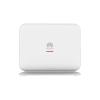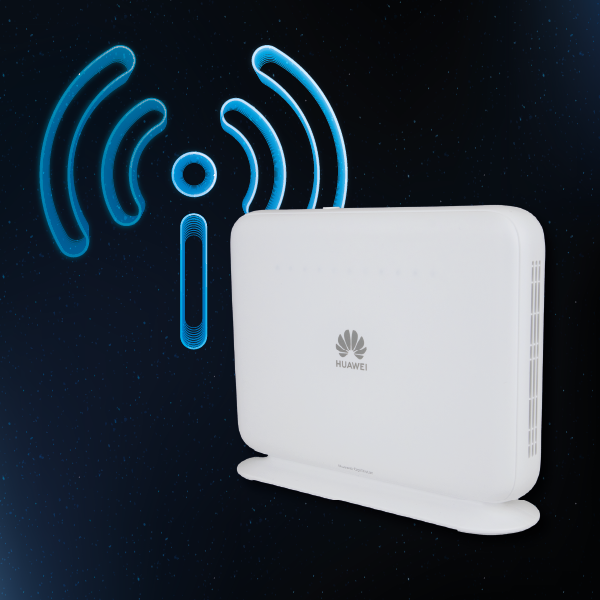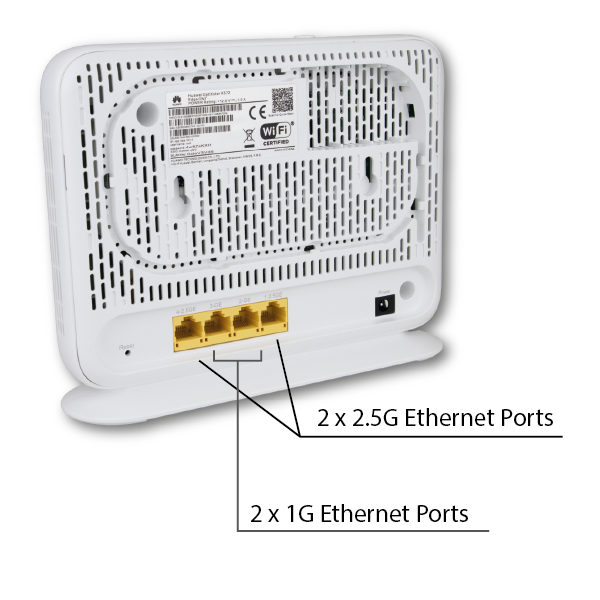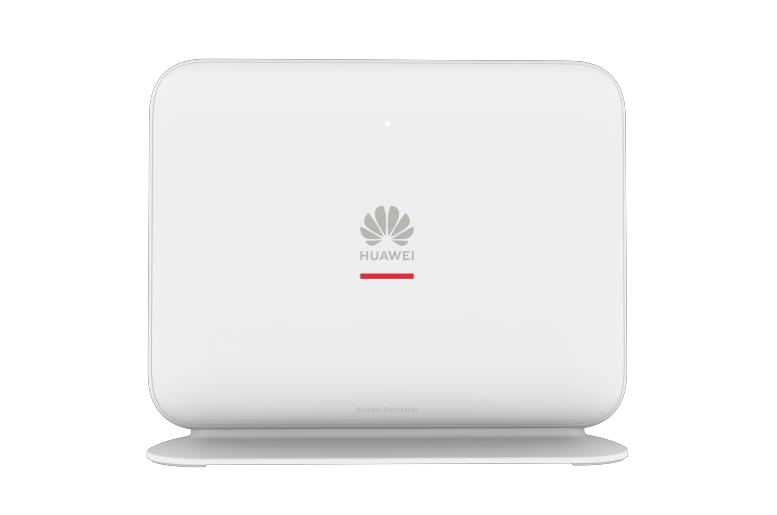-
€

Huawei OptiXstar K572 is a wireless router that supports Wi-Fi 7. It uses IEEE 802.11 b/g/n/ax/be protocols in the 2.4 GHz band and IEEE 802.11 a/n/ac/ax/be in the 5 GHz band. The maximum theoretical transmission throughput is 688 Mbps on 2.4 GHz (2x2 MIMO) and 2882 Mbps on 5 GHz (2x2 MIMO). This is a higher speed than what standard Wi-Fi 6 solutions with 2x2 MIMO offer. The main advantage of the K572 is its two 2.5G Ethernet ports (10/100/1000/2500 Mbps), one of which serves as a WAN port and the other as a LAN port. This allows you to offer subscribers 2.5 Gbps packages and provide them with equipment capable of handling such throughput. Additionally, the router has two more gigabit Ethernet LAN ports (10/100/1000 Mbps).
The offered product supports the Mesh function – together with other compatible devices, it can create a unified, extensive wireless network. Individual devices within this network can communicate with each other wirelessly, without the need for Ethernet cabling. Pairing is very simple and can be done using a button. The K572 supports automatic Wi-Fi configuration synchronization and wireless channel usage optimization. Additionally, the router supports Wi-Fi roaming – IEEE 802.11k/v protocols. The device is best suited for subscribers who have large houses or apartments. It can be installed together with an ONT terminal to ensure adequate wireless network coverage.

Wi-Fi 7 BE3600
The device can transmit a wireless network using the Wi-Fi 7 standard. It utilizes IEEE 802.11 b/g/n/ax/be protocols in the 2.4 GHz band and IEEE 802.11 a/n/ac/ax/be in the 5 GHz band. The maximum theoretical throughput is 688 Mbps on 2.4 GHz and 2882 Mbps on 5 GHz.
Wi-Fi 7 is not only about higher network speeds but also introduces other useful features. The most important of these is MLO – Multi-Link Operation. It allows a connection to be established across more than one frequency band simultaneously, whereas in previous Wi-Fi generations, users could only connect to the router in one specific band. Multi-RU enables the allocation of non-contiguous portions of the channel to users, which translates to significantly better utilization of available frequency spectrum.
Integrated Omnidirectional Antennas
Inside the housing are four integrated omnidirectional antennas. Their gain is 4 dBi in the 2.4 GHz band and 5 dBi in the 5 GHz band. Combined with the Beamforming function, they provide a high and reliable level of wireless coverage.


2 x 2.5G Ethernet Ports, 2 x 1G Ethernet Ports
The router is equipped with 2 x 2.5G Ethernet ports and 2 x 1G Ethernet ports, including 1 WAN port (2.5G Ethernet) and 3 LAN ports. All ports support automatic link speed negotiation — even the 2.5GE ports can operate in 10 / 100 Mbps modes. If you're using a wireless WAN connection, all Ethernet ports function as LAN ports. The K572 automatically detects the type of connection without the need to manually switch between WAN and LAN modes.
Mesh Network
The offered product can operate in a Mesh network with a tree topology. If you're using a Huawei ONT terminal at home, you can wirelessly connect the K572 to it via the WPS button. This allows the creation of a large-scale wireless network that will appear under a single name to the user. The router supports Wi-Fi roaming (802.11k/v standards) and automatic synchronization of Wi-Fi configuration.


Application
The Huawei H572 is best used in combination with a Huawei ONT terminal to extend an existing wireless network and increase its coverage. The 2.5G Ethernet ports provide very high wired connection throughput, while Wi-Fi 7 offers the highest currently available standard for wireless connectivity. Due to all these advantages, the offered product is also an excellent solution for use as a standalone router.
Specifications
| Huawei K572 | |
| Physical | |
|---|---|
| Dimensions (H x W x D) | 140 mm × 188 mm × 35 mm (excluding the base) |
| System power supply | 12 V DC, 1 A |
| Rated Power Input for Power Adapter | 100 - 240 V AC, 50/60 Hz |
| Max power consumption | < 12 W |
| Indicator | 1 status indicators |
| Buttons |
Reset button WLAN/WPS button |
| Memory | 128 MB Flash, 256 MB RAM |
| Installation mode | Vertically placed on a desk or mounted on a wall |
| Operating temperature | 0°C to 40°C |
| Operating humidity | 5% RH to 95% RH (noncondensing) |
| Interface |
NNI (WAN): 2.5G Ethernet or Wi-Fi UNI (LAN):
|
| Wi-Fi | |
| Supported Protocol |
Wi-Fi 7
2,4 GHz: IEEE 802.11 b/g/n/ax/be 5 GHz: IEEE 802.11 a/n/ac/ax/be |
| Antenna gain |
2,4 GHz: 4 dBI 5 GHz: 5 dBi |
| MIMO | 2×2 MIMO (2.4GHz&5GHz) |
| Air interface rate |
2,4 GHz: 688 Mb/s 5 GHz: 2882 Mb/s |
| Others |
WMM(Wi-Fi Multimedia) Beamforming Band steering 4096 QAM 160 MHz channel width WPA3 MU MIMO MLO (Multi-Link Operation) Multi-RU |
| Interface | |
| Ethernet port |
Limit on the number of learned MAC addresses MAC address learning GE port supports auto-adaptive 10 Mbit/s, 100 Mbit/s or 1000 Mbit/s 2.5GE port supports auto-adaptive 10 Mbit/s, 100 Mbit/s, 1000 Mbit/s or 2500 Mbit/s |
| Feature | |
|
Home Network |
Working with gateway supports the following features:
|
| Home Network Management | Working with the iMaster NCE platform supports remote management and maintenance |
| Smart Interconnection |
2 upstream modes: Ethernet upstream mode and Wi-Fi upstream mode
be connected to the iMaster NCE platform)
2-level cascading networking) |
| Layer 3 Features |
PPPoE/static IP/DHCP NAT/NAPT Port forwarding ALG, UPnP DDNS/DNS server/DNS client IPv6/IPv4 dual stack Static/default routes |
| O&M | Web UI Dual-system software backup and rollback |
| Security |
SPI firewall Parent control |






 Polski
Polski English
English Italiano
Italiano Español
Español Čeština
Čeština Српски
Српски Deutsch
Deutsch Ελληνικά
Ελληνικά Slovenský
Slovenský





